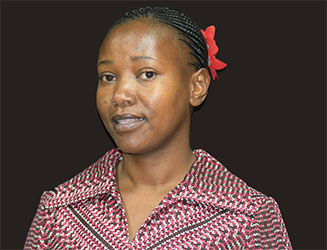Staff Profile

BIO
Dr. Eva Shayo received her BSc and MSc in Telecommunications Engineering from the University of Dar es Salaam Tanzania in 2008 and 2015 respectively. She graduated her PhD in 2022
RESEARCH
Long-Range Wide Area Network
Slotted Synchronization Scheme in LoRaWAN
LoRaWAN has recently become of more interest to both academia and industrial practitioners as it operates in an unlicensed Industrial Scientific Mechanical (ISM) band. The LoRa network is divided into the LoRa physical layer and the LoRa Wide Area Network (LoRaWAN) as a MAC layer. The physical layer is a proprietary standard managed by Semtech, while LoRaWAN is an open standard managed by LoRa Alliance.
Despite its advantages, LoRaWAN uses ALOHA as the medium access control mechanism in which the EDs transmit when they have packets to transmit and retransmit if the transmission failed. The use of ALOHA in the LoRAWAN limits the scalability of LoRaWAN as the EDs transmit randomly when they have packets to transmit and retransmit if collision occurs. This results in collisions as the number of EDs increases in the network and hence affecting the overall performance of the LoRa network. In addition, the re-transmission trials of ALOHA may drain the limited power of the EDs resulting in a short lifetime of the EDs.
Several studies have been conducted to address the limitations of ALOHA in LoRaWAN. However, the methods used either implement schemes that need to sense for the channel before data transmissions or scheduling algorithms that force devices to transmit in a predefined time slot. The use of time slots not only eliminate collisions but also improve the energy efficiency of the EDs when compared to sensing schemes. However, most of the scheduling scheme or algorithm uses random synchronization procedures which are venerable to collisions and energy inefficient. Therefore, an algorithm that can be used in LoRaWAN without collisions and improved energy efficiency is desired to improve the scalability of the LoRa network without affecting the performance of the network.
A work to propose and evaluate slotted synchronization scheme in LoRaWAN has been done. The proposed synchronization approach can work to synchronize LoRaWAN EDs using device ID in slotting the EDs to send the synchronization requests to the gateway. The slotted transmission approach in the proposed slotted synchronization was based on the device ID which forces devices with large ID to unfairly wait for a long time before transmitting the synchronization request to the gateway. Therefore, an innovative slot assignment technique independent to device ID can be considered as future work.
Performance Evaluation of dynamic Mult frame Multi Spreading Factor TDMA Scheduling Algorithm in LoRaWAN: Case of Okumura Hata Propagation Model
LoRaWAN has recently become of more interest to both academia and industrial practitioners as it operates in an unlicensed Industrial Scientific Mechanical (ISM) band. The LoRa network is divided into the LoRa physical layer and the LoRa Wide Area Network (LoRaWAN) as a MAC layer. The physical layer is a proprietary standard managed by Semtech, while LoRaWAN is an open standard managed by LoRa Alliance.
Despite its advantages, LoRaWAN uses ALOHA as the medium access control mechanism in which the EDs transmit when they have packets to transmit and retransmit if the transmission failed. The use of ALOHA in the LoRAWAN limits the scalability of LoRaWAN as the EDs transmit randomly when they have packets to transmit and retransmit if collision occurs. This results in collisions as the number of EDs increases in the network and hence affecting the overall performance of the LoRa network. In addition, the re-transmission trials of ALOHA may drain the limited power of the EDs resulting in a short lifetime of the EDs.
Several studies have been conducted to address the limitations of ALOHA in LoRaWAN. However, the methods used either implement schemes that need to sense for the channel before data transmissions or scheduling algorithms that force devices to transmit in a predefined time slot. The use of time slots not only eliminate collisions but also improve the energy efficiency of the EDs when compared to sensing schemes. Some of the scheduling solutions define fixed time slot for each individual end device to transmit without considering the synchronization which may result to collision due clock shifts in the end device caused by change in surrounding temperature and device aging. Other scheduling solutions considered synchronizing the EDs before performing data transmission in their fixed scheduled time slot but the synchronization procedure is still random causing unavoidable collisions. The synchronization and scheduling algorithms also use one super frame with fixed number of time slots which limits the network scalability and may result into unused slot in a frame when a device has nothing to transmit. A dynamic Multi Frame Multi SF (MFMSF) TDMA scheduling algorithm with slotted synchronization procedure was developed to reduce collisions and improve the energy efficiency of the end device. The algorithm uses multiple frames in multiple Spreading Factor (SF)to improve the network scalability. However, the proposed dynamic MFMSF TDMA scheduling algorithm uses the Log distance loss propagation models to assign different SFs to the EDs. Evaluating the performance of dynamic MFMSF TDMA scheduling algorithm with other loss propagation models such as Okumura Hata is also recommended for future work. The evaluation can consider both standard LoRaWAN and industrial LoRaWAN applications.
Performance Evaluation of dynamic MFMSF TDMA Scheduling Algorithm in Outdoor Industrial LoRaWAN
Industrial network setup differs from the normal network in three aspects including the wireless channel, the traffic pattern and the quality of service (QoS) requirements. The wireless channel is associated with losses due to fading, shadowing, interference and attenuation due to distance. The industrial wireless channel is particularly complex, and channel models need to take into account the presence of obstacles, signal reflections, delays, and noise caused by machines. In addition, industrial applications have stringent QoS requirements in terms of reliability, timeliness, robustness, determinism, energy efficiency, and security which should be met by any network connecting devices in the industrial scenario.
LoRaWAN is a promising long range low power wide area network in industrial applications. The network can be used in both indoor and outdoor industrial applications because it is possible to create proprietary network that can be managed and controlled much more ease than other public networks. The parameter settings for the LoRaWAN network are different when used in industrial applications and standard networks. The network setup should adhere to the industrial setup which consists of several sensors placed in different areas to monitor the status of a machine or an industrial process. The signal propagation is different in the different setups depending on the density of machines, the position of objects in the space and the material they are made of.
The dynamic MFMSF TDMA scheduling algorithm has shown interesting performance in indoor industrial setup. Therefore, evaluating the performance of the algorithm in the outdoor industrial use case can also be considered.
The performance of dynamic MFMSF TDMA scheduling algorithm in a multi-gateway network structure
The LoRaWAN network architecture can be implemented using either single gateway or multiple gateway network architecture. The data transmission algorithms in the multi-gateway network structure may be different from those used in a single gateway network architecture. The question is what is the performance of MFMSF TDMA scheduling algorithm in the Multi-gateway setup?

